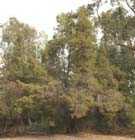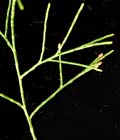Conservation Status

Callitris gracilis
R.T.Baker (1904)
Common names
Slender cypress-pine, maroong [aboriginal]. Subspecies murrayensis is Murray pine or mallee pine.
Taxonomic notes
Type: plate XLV in Baker (1904), based on collections near Rylstone, New South Wales. Until about 2020, this taxon was generally known as Callitris preissii, although the Flora of Australia had recognized it as distinct as early as 1998, distinguishing the two species only by surface texture of the seed cone (and distribution, which is largely disjunct). The molecular analysis by Larter et al. (2017) supported this, placing C. gracilis in a clade with 5 other species, sister to C. preissii in a clade with two other species, these two clades having diverged about 10 million years ago (late Miocene). See also Callitris tuberculata.
See POWO or the Atlas of Living Australia for the full synonymy. Two subspecies, the type and subsp. murrayensis, were formerly recognized, but have been reduced to synonymy by both POWO and the Atlas of Living Australia; the molecular analysis by Pye et al. (2003) placed samples of each subspecies as sisters. The same analysis identified C. tuberculata as sister to C. gracilis. The subspecies still have some conceptual value, as shown in the discussion below, but the distinctions are minor and it is not apparent that they have taxonomic significance. C. verrucosa was also named as a subspecies by Harden (1990), who stated that subspecies verrucosa and murrayensis intergrade and are often difficult to determine satisfactorily. However, current taxonomy retains C. verrucosa as a valid species. There are (unnamed) hybrids with C. columellaris and C. verrucosa (Harden 1990, Hill 1998).
Description
Monoecious evergreen trees up to 20 m tall with spreading to erect branches. Leaves 2-4 mm long on smallest twigs, green, abaxially rounded. Pollen cones cylindrical, clustered, up to 5 mm long. Seed cones solitary or grouped on stout, often clustered twigs, ovoid to depressed-globular, 25-30 mm diameter, persistent and retaining seed for several years after maturity; cone scales 6, thick, smooth or sparsely tuberculate, occasionally with a very small dorsal point below the apex, united below to form a thick cone base, not spreading widely after the cone opens, alternate scales reduced, larger scales apically abruptly obtuse; columella thick, entire, 3-angled, 2-4 mm high. Seeds numerous, dark brown, with 2-3 wings c. 4 mm wide (Hill 1998). If you wish to distinguish the subspecies, the only difference is that the type has oblate seed cones and subsp. murrayensis has elongate cones (Hill 1998). See García Esteban et al. (2004) for a detailed characterization of the wood anatomy.
Distribution and Ecology
Australia: New South Wales, Victoria, and southeastern South Australia. According to Harden (1990), subsp. preissii is found throughout the species' range on sandstone hillsides, and in New South Wales, is "chiefly in the Rylstone to Goulburn R. district"; whereas subsp. murrayensis is found in New South Wales, Victoria, and South Australia, but principally grows along the Murray River valley, especially on sandy ridges. Hill (1998) describes the species as "abundant" in the lower Murray River valley in NSW and Victoria, extending to coastal southeastern South Australia, and mostly in alkaline clay or calcareous sandy soils. Subsp. gracilis predominates on calcareous beach dunes in southeastern South Australia, with a disjunct population on sandstone in the upper Goulburn River valley of NSW. Subsp. murrayana is most abundant on alluvial flats of the Murray River, but extends west to the Flinders and Lofty ranges, and central Eyre Peninsula (Hill 1998). Besides these locales, the species is introduced and locally naturalized at locations in NSW, Vic, SA, and WA, as shown on the range map at right.
Zone 10 (cold hardiness limit between -1°C and +4.4°C) (Bannister and Neuner 2001).
Note that the IUCN conservation assessment that rates this species as "Least Concern" does not distinguish between C. gracilis and C. preissii. Nonetheless, the species is so numerous and widely distributed that the "Least Concern" rating is probably accurate.
Remarkable Specimens
The current largest known specimen is a tree in Yamba SA, Victoria, that measures 90.4 cm dbh and is 14 m tall with a crown spread of 17 m (National Register of Big Trees 2018).
Ethnobotany
Aborigines on the Murray River made a combined canoe pole and fish spear nearly 4 m long from the wood of the tree. The resin provided a cement for fastening barbs to spears (ANBG 2002).
Observations
No data as of 2024.12.04.
Remarks
The epithet gracilis likely refers to the drooping twigs, repeatedly mentioned by Baker (1904), who says "The long, fine, drooping branchlets occasionally give it a willow-like appearance."
Citations
ANBG 2002. Australia National Botanical Garden, Aboriginal Trail page. http://osprey.erin.gov.au/anbg/aboriginal-trail.html, accessed 2002.01.18, now defunct.
Baker, R.T. 1904. On a new species of Callitris from eastern Australia. Proc. Linn. Soc. New South Wales 27:839-841 and Plate XLV. Available: Biodiversity Heritage Library, accessed 2024.12.04.
Larter, M., S. Pfautsch, J.-C. Domec, S. Trueba, N. Nagalingum, and S. Delzon. 2017. Aridity drove the evolution of extreme embolism resistance and the radiation of conifer genus Callitris. New Phytologist 215:97-112.
National Register of Big Trees. 2018. [Unnamed document]. https://www.nationalregisterofbigtrees.com.au/tree_trivia_details_2018.pdf, accessed 2019.03.26.
Pye, M. G., P. A. Gadek, and K. J. Edwards. 2003. Divergence, diversity and species of the Australasian Callitris (Cupressaceae) and allied genera: evidence from ITS sequence data. Australian Systematic Botany 16(4):505-514. https://doi.org/10.1071/SB02019.
See also
Farjon (2005) provides a detailed account, with illustrations.





